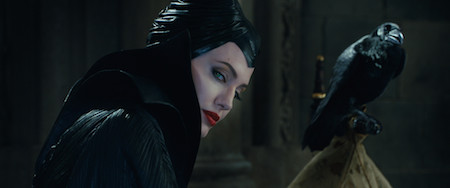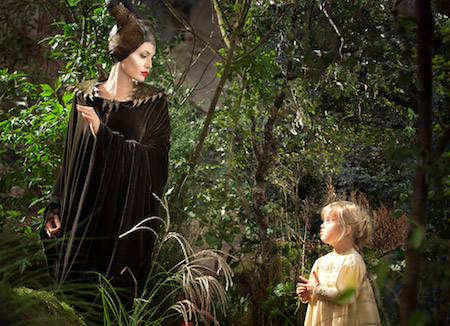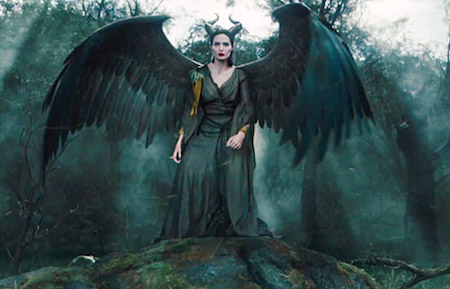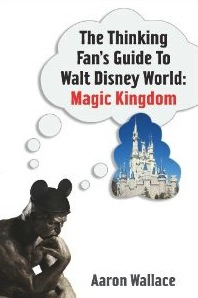The following review contains a few minor spoilers.
Maleficent didn’t need to exist, but I’m glad it does. It’s the latest fairy tale with a twist, where the bend is once again that the bad guy was a good guy after all… a well-worn tenet of postmodern entertainment.
But fascinated as we are with finding good in evil, there’s also a tendency to resist the redemption of a villain. And for good reason. As recent headlines have reminded us, evil is all too real in our world, and whatever context we might uncover does little to absolve it of its darkness.
So when we acquit a villain of their villainy, we also compromise to some extent our belief in right and wrong — and, by extension, our belief in absolute truth. And that’s a lot for Angelina Jolie to ask of us, to be honest.
I suspect that’s why initial reaction to Maleficent has been so mixed.

This movie is of great personal interest to me, having long been fascinated by Maleficent, probably my favorite character in the Disney canon. Ten years ago, I reflected on her physical construction when she ranked #1 on UltimateDisney.com’s Villains Countdown (an article that ultimately found itself referenced in Jeff Kurti’s bestselling Disney Dossiers book).
Later, on an episode of Zip-A-Dee-Doo-Pod, a listener asked why I’d rank Maleficent higher than a more nuanced villain, such as Judge Frollo from The Hunchback of Notre Dame. I replied like this:
Certainly, in Sleeping Beauty, we do not get a character study with Maleficent. For the most part, she’s evil just because she’s evil. And I understand wanting more than that as a viewer. But Maleficent represents evil in an absolute sense. And I’m someone who believes in the existence of absolute evil and absolute good.
That dichotomy is very black and white, so maybe it’s not as intellectually stimulating to someone who’s trying to think critically about a story.
But I think that, coming from a Judeo-Christian perspective, if you believe in this existence of good and of God and holiness, and on the other end of the spectrum, evil and hatred and Satan and Hell — to have a character like Maleficent as a kind of Satan figure — that’s scary. If you are someone who believes that that actually exists in the real world — well then this character who is offered up as evil just because she’s evil suddenly becomes a little more real-life. Frollo exemplifies human traits; Maleficent then exemplifies spiritual traits… and that can be a really scary thing.
There’s that scene in Sleeping Beauty where Maleficent actually summons “all the powers of Hell” to transform herself into this giant, fire-breathing dragon. That’s pretty freakin’ scary.
So you have, on the one hand, characters who represent human corruption, like Judge Frollo or Lady Tremaine. They represent the downfallen, corruptible human. And then you have characters like Maleficent, who represent the corrupting force. It’s characters like Maleficent who bring people like Frollo into being.
So no, I don’t think Maleficent needed Wicked-izing. Her story as presented in Disney’s Sleeping Beauty was not, to my mind, unsatisfying. And I gather that many of this week’s theatergoers feel the same way. But that doesn’t mean there isn’t room out there for second guessing.
Maleficent is nothing more than a thought experiment. A “what if?.” A hypothetical for your consideration. It does not alter, diminish, or revise the story we all cherish any more than Walt Disney tattered Charles Perrault’s original fairy tale in 1959. I just checked and my Sleeping Beauty Blu-ray is still on the shelf. There, Maleficent’s still a green-skinned tyrant perfectly content to spend sixteen years solidifying an innocent child’s demise all because she got unfriended on Facebook left off a guest list. And unless Angelina Jolie physically swipes my DVDs for her enormous family, she’s never going to change that.
But just because Maleficent didn’t need to exist doesn’t mean that it shouldn’t. Actually, it has a lot to offer — namely, a captivating emotional narrative and a nearly Streep-caliber performance by Jolie.

Don’t get me wrong, though. Plenty goes wrong. For instance: the three fairies. I’ve long argued that they’re the real protagonists in Disney’s Sleeping Beauty, so to see them not only sidelined but also caricatured is disheartening. They’re CGI’d to the point of Polar Express elf-dom, and while Imelda Staunton lends some weight, the other two are so annoying they could have flanked Meryl in Mamma Mia!. Oh, and what’s with the changed names? Surely a film that goes so far as to recite verbatim an entire scene from the animated classic isn’t above a name like Merryweather.
(Speaking of names, why did everyone in the film decide halfway through to start pronouncing “Stefan” like he’s about to promote New York’s hottest nightclub?)
Meanwhile, I understand needing Maleficent to be the one who reduces Aurora’s sentence from death to dozing, but why would the filmmakers leave the third fairy’s gift un-granted? Screenwriter Linda Woolverton had a chance to answer our long-standing question about what Merryweather had originally intended to give Aurora. But she just ignores it instead.
There’s also the problem of pacing. Maleficent’s turn toward evil — which should have been the film’s predominate arc of interest — happens at breakneck speed, while we spend way too much time watching Angelina hang out in trees. Seriously… Tarzan, Owl, George of the Jungle, Kaa, and Ke$ha combined have logged less timber time.

But all those faults fail to outweigh the movie’s prevailing worth. It is a story about Maleficent’s relationships, which are conveyed so genuinely and explored so thoughtfully that one can’t help but feel caught up in them. The story is thin, but Maleficent gets away with it because we already know the essential plot points here. It’s not about story, anyway. This is a character piece, and a fine one.
Jolie summons righteousness, betrayal, anguish, and affection from the same emotional well that she pulled Changeling out of in 2008. She’s like a singer who taps into some secret, personal experience to convey in voice what we can’t express in words. For the oft-derided actress, this is transcendence. Elle Fanning’s sincere sweetness is a surprising complement, but it’s Jolie who carries the film. She’s all it needs.
Woolverton isn’t nearly as intellectual here as in 2010’s Alice in Wonderland, but she’s still good for throwing a fairy tale down the rabbit hole now and then.
For more of Aaron’s thoughts on Disney films — and their connections to theme parks (and much more) — be sure to check out his bestselling book, The Thinking Fan’s Guide to Walt Disney World: Magic Kingdom — available in bookstores and on iBooks, Kindle, and Nook.
All images of Maleficent copyright Walt Disney Pictures, 2014.
